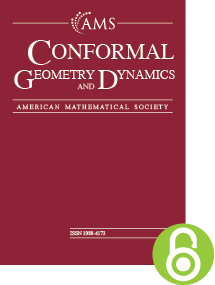Cycle doubling, merging, and renormalization in the tangent family
HTML articles powered by AMS MathViewer
- by Tao Chen, Yunping Jiang and Linda Keen
- Conform. Geom. Dyn. 22 (2018), 271-314
- DOI: https://doi.org/10.1090/ecgd/327
- Published electronically: November 28, 2018
- PDF | Request permission
Abstract:
In this paper we study the transition to chaos for the restriction to the real and imaginary axes of the tangent family $\{ T_t(z)=i t\tan z\}_{0< t\leq \pi }$. Because tangent maps have no critical points but have an essential singularity at infinity and two symmetric asymptotic values, there are new phenomena: as $t$ increases we find single instances of “period quadrupling”, “period splitting”, and standard “period doubling”; there follows a general pattern of “period merging” where two attracting cycles of period $2^n$ “merge” into one attracting cycle of period $2^{n+1}$, and “cycle doubling” where an attracting cycle of period $2^{n+1}$ “becomes” two attracting cycles of the same period.
We use renormalization to prove the existence of these bifurcation parameters. The uniqueness of the cycle doubling and cycle merging parameters is quite subtle and requires a new approach. To prove the cycle doubling and merging parameters are, indeed, unique, we apply the concept of “holomorphic motions” to our context.
In addition, we prove that there is an “infinitely renormalizable” tangent map $T_{t_\infty }$. It has no attracting or parabolic cycles. Instead, it has a strange attractor contained in the real and imaginary axes which is forward invariant and minimal under $T^2_{t_\infty }$. The intersection of this strange attractor with the real line consists of two binary Cantor sets and the intersection with the imaginary line is totally disconnected, perfect, and unbounded.
References
- A. Arneodo, P. Coullet, and C. Tresser, A possible new mechanism for the onset of turbulence, Phys. Lett. A 81 (1981), no. 4, 197–201. MR 598769, DOI 10.1016/0375-9601(81)90239-5
- Charles Tresser and Pierre Coullet, Itérations d’endomorphismes et groupe de renormalisation, C. R. Acad. Sci. Paris Sér. A-B 287 (1978), no. 7, A577–A580 (French, with English summary). MR 512110
- T. Chen and L. Keen, Dynamics of Generalized Nevanlinna Functions, arXiv:1805.10974 (2018).
- Robert L. Devaney and Linda Keen, Dynamics of tangent, Dynamical systems (College Park, MD, 1986–87) Lecture Notes in Math., vol. 1342, Springer, Berlin, 1988, pp. 105–111. MR 970550, DOI 10.1007/BFb0082826
- Adrien Douady, Systèmes dynamiques holomorphes, Bourbaki seminar, Vol. 1982/83, Astérisque, vol. 105, Soc. Math. France, Paris, 1983, pp. 39–63 (French). MR 728980
- A. Douady, Chirurgie sur les applications holomorphes, Proceedings of the International Congress of Mathematicians, Vol. 1, 2 (Berkeley, Calif., 1986) Amer. Math. Soc., Providence, RI, 1987, pp. 724–738 (French). MR 934275
- N. Fagella and L. Keen, Stable components in the parameter plane of meromorphic functions of finite type, arXiv:1702.06563 (2018).
- Mitchell J. Feigenbaum, Quantitative universality for a class of nonlinear transformations, J. Statist. Phys. 19 (1978), no. 1, 25–52. MR 501179, DOI 10.1007/BF01020332
- Mitchell J. Feigenbaum, The universal metric properties of nonlinear transformations, J. Statist. Phys. 21 (1979), no. 6, 669–706. MR 555919, DOI 10.1007/BF01107909
- Frederick P. Gardiner, Yunping Jiang, and Zhe Wang, Holomorphic motions and related topics, Geometry of Riemann surfaces, London Math. Soc. Lecture Note Ser., vol. 368, Cambridge Univ. Press, Cambridge, 2010, pp. 156–193. MR 2665009
- Yunping Jiang, Geometry of Cantor systems, Trans. Amer. Math. Soc. 351 (1999), no. 5, 1975–1987. MR 1475687, DOI 10.1090/S0002-9947-99-02214-X
- Yunping Jiang, Renormalization and geometry in one-dimensional and complex dynamics, Advanced Series in Nonlinear Dynamics, vol. 10, World Scientific Publishing Co., Inc., River Edge, NJ, 1996. MR 1442953, DOI 10.1142/9789814350105
- Linda Keen, Complex and real dynamics for the family $\lambda \tan (\textbf {z})$, Sūrikaisekikenkyūsho K\B{o}kyūroku 1269 (2002), 93–102. Complex dynamics and related fields (Japanese) (Kyoto, 2001). MR 1955818
- Linda Keen and Janina Kotus, Dynamics of the family $\lambda \tan z$, Conform. Geom. Dyn. 1 (1997), 28–57. MR 1463839, DOI 10.1090/S1088-4173-97-00017-9
- Linda Keen and Janina Kotus, On period doubling phenomena and Sharkovskii type ordering for the family $\lambda \tan (z)$, Value distribution theory and complex dynamics (Hong Kong, 2000) Contemp. Math., vol. 303, Amer. Math. Soc., Providence, RI, 2002, pp. 51–78. MR 1943527, DOI 10.1090/conm/303/05240
- G. Levin, S. van Strien, and W. Shen, Monotonicity of entropy and positively oriented transversality for families of interval maps, arXiv:1611.10056v1 (2016).
- Curtis T. McMullen, Complex dynamics and renormalization, Annals of Mathematics Studies, vol. 135, Princeton University Press, Princeton, NJ, 1994. MR 1312365
- Welington de Melo and Sebastian van Strien, One-dimensional dynamics, Ergebnisse der Mathematik und ihrer Grenzgebiete (3) [Results in Mathematics and Related Areas (3)], vol. 25, Springer-Verlag, Berlin, 1993. MR 1239171, DOI 10.1007/978-3-642-78043-1
- John Milnor, Dynamics in one complex variable, Friedr. Vieweg & Sohn, Braunschweig, 1999. Introductory lectures. MR 1721240
- John Milnor, On the concept of attractor, Comm. Math. Phys. 99 (1985), no. 2, 177–195. MR 790735, DOI 10.1007/BF01212280
Bibliographic Information
- Tao Chen
- Affiliation: Department of Mathematics, Engineering and Computer Science, Laguardia Community College, CUNY, 31-10 Thomson Avenue, Long Island City, New York 11101
- MR Author ID: 1004078
- Email: tchen@lagcc.cuny.edu
- Yunping Jiang
- Affiliation: Department of Mathematics, Queens College of CUNY, Flushing, New York 11367; and Department of Mathematics, CUNY Graduate School, New York, New York 10016
- MR Author ID: 238389
- Email: yunping.jiang@qc.cuny.edu
- Linda Keen
- Affiliation: Department of Mathematics, CUNY Graduate School, New York, New York 10016
- MR Author ID: 99725
- Email: linda.keen@lehman.cuny.edu
- Received by editor(s): January 23, 2018
- Received by editor(s) in revised form: July 26, 2018
- Published electronically: November 28, 2018
- Additional Notes: All three authors were partially supported by awards from PSC-CUNY. The second author was partially supported by grants from the Simons Foundation [grant number 523341], the NSF [grant number DMS-1747905), and the NSFC [grant number 11571122].
- © Copyright 2018 American Mathematical Society
- Journal: Conform. Geom. Dyn. 22 (2018), 271-314
- MSC (2010): Primary 37F30, 37F20, 37F10; Secondary 30F30, 30D30, 32A20
- DOI: https://doi.org/10.1090/ecgd/327
- MathSciNet review: 3880593


